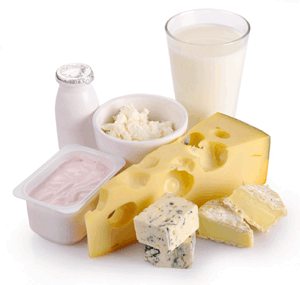Milk and milk products
A dairy product is food produced from the milk of various mammals. A production plant where the processing of milk takes place is called a dairy.
Nutritional Components of Milk:
Proteins:
Most of the nitrogen is found in the form of protein. The building blocks of all proteins are the amino acids. There are 20 amino acids that are commonly found in proteins. The concentration of protein varies from 3.0 to 4.0% .
Carbohydrates:
The principal carbohydrate is lactose. Although it is a sugar, lactose is not noticeably sweet to taste. The concentration of lactose in the milks is relatively constant and averages about 5% .
Fat:
Normally, fat makes up from 3.5 to 6.0%, varying between breeds of cattle and with feeding practices. Fat is present in milk in small globules suspended in water.
Minerals and vitamins:
Milk is an excellent source of most minerals required for the growth of the The digestibility of calcium and phosphorus are unusually high, in part because they are found in association with the casein of the milks. As a result, it is the best source of calcium for skeletal growth in the young and maintenance of bone integrity in adults.
Water:
The nutritional value of milks as a whole is greater than the value of its individual nutrients because of its unique nutritional balance. The amount of water reflects that balance. In all animals, water is the nutrient required in the greatest amount and milk does supply a great amount of water—it contains approximately 90% water.
Processing Milk:
Pasteurization: Pasteurization is used to kill harmful microorganisms by heating the mi lk for a short time and then cooling it for storage and transportation. Pasteurization is named after Lois Pasteur. Pasteurized m ilk still is perishable, however, and must be stored cold by both suppliers and consumers. UHT – A newer process, ultra-pasteurization or ultra-high temperature treatment (UHT), heats the milk to a higher temperature for a shorter amount of time. This extends its shelf life and allows the milk to be stored unrefrigerated because of the longer lasting sterilization effect.
Creaming and homogenization: Upon standing for 12 to 24 hours, fresh milk has a tendency to separate into a high-fat cream layer on top of a larger, low-fat mi lk layer. The cream often is sold as a separate product with its own uses. Today the separation of the cream from the milk usually is accomplished rapidly in cream separators. The fat globules rise to the top of a container of milk because fat is less dense than water. The smaller the globules, the more other molecular-level forces prevent this from happening. In fact, the cream rises in cow’s milk much more quickly than a simple model would predict: rather than isolated globules, the fat in the milk tends to form into clusters containing about a million globules, held together by a number of minor whey proteins. These clusters rise faster than individual globules can. The fat globules in milk from goats, sheep, and water buffalo do not form clusters as readily and are smaller to begin with, resulting in a slower separation of cream from these milks.
Milks are often is homogenized, a treatment that prevents a cream layer from separating out of the milks. It is pumped at high pressures through very narrow tubes, breaking up the fat globules through turbulence and cavitations. A greater number of smaller particles possess more total surface area than a smaller number of larger ones, and the original fat globule membranes cannot completely cover them. Casein micelles are attracted to the newly exposed fat surfaces. Nearly one-third of the micelles are end up participating in this new membrane structure. The casein weighs down the globules and interferes with the clustering that accelerated separation. The exposed fat globules are vulnerable to certain enzymes present in milks, which could break down the fats and produce rancid flavours. To prevent this, the enzymes are inactivated by pasteurizing the milks immediately before or during homogenization.
List of dairy Products:
- Clotted cream made by heating unpasteurized milk and leaving it until the cream rises to the surface. Traditionally serve with scones.

- Milk Powder is dehydrated milk – is heated in a metal sheet ,to evaporate the water content Long shelf time and easy transportation are advantages. It is used in the process of making various other products like ice-cream, infant formula and milk chocolate.
- Condensed-milks exist in various formulas, normally it is a high fat product that is obtained by removing water and adding sugar. Often use in desserts. Although similar products were used over a thousand years ago in Central Asia the modern form was invented in Europe in the early 19th century.
- Skimmed-milks are pasteurized milk from which nearly all fat has removed. The vitamin content is also reduced.
- Semi-skimmed milks are also pasteurized from which some of the fat removed with consequent reduction in vitamin content.
- Butter is produced in a process where you churn the cream, made from cow´s milk.
- Buttermilk is the liquid that is left over when you have churned the cream into butter. It is thicker than milk but not necessarily fatter.
- Ghee Invented by the Indians, it is called clarified butter in English. By melting butter you separate the milk substances from the butter, the result can store for longer periods in closed containers.
- Cheese is manufactured by various methods of coagulating-milk and thus removing liquid called whey, rennet is normally added to this “curd” to make it stabilize. The cheese can then sit to let ripen creating taste with the help of bacteria and sometimes mold fungus. There are hundreds of methods where cheese can be cooked, dried or flavoured before consumed. The origin of cheese is uncertain, but to say several thousands of years ago somewhere in the Middle East, Europe or Northern Africa you won´t be wrong.
- Curd is the solidified form of milk when it has coagulated with the help of acid or rennet.
- Whey is the liquid that gets separated from the curd in cheese making. It can be used in baking or for other foods.
- Cottage cheese Can be made with or with out rennet with different results. Origin and age is quite unknown, it can probably be connected with general cheese making.
- Lassi is an Indian yogurt drink. It is a mix with yogurt, milk, spices and sometimes fruit.
- Ice-Cream exists in a number of varieties and has a long history. The ancient Chinese is believed to have been the first to eat one made from m ilk. A traditional way to make it is to slowly freeze flavoured cream, eggs is sometimes used to emulsify.





